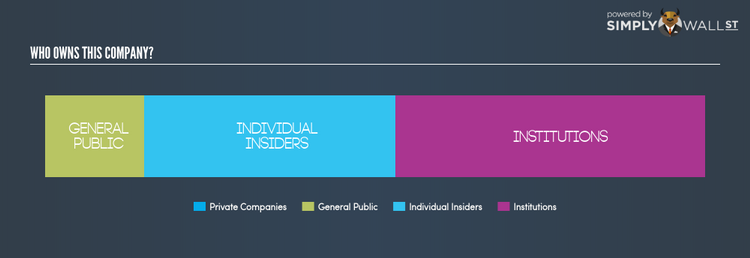Why Starvest plc’s (LON:SVE) Investor Composition Impacts Your Returns

In this article, I’m going to take a look at Starvest plc’s (AIM:SVE) latest ownership structure, a non-fundamental factor which is important, but remains a less discussed subject among investors. Ownership structure has been found to have an impact on shareholder returns in both short- and long-term. Since the same amount of capital coming from an activist institution and a passive mutual fund has different implications on corporate governance, it is a useful exercise to deconstruct SVE’s shareholder registry.
View our latest analysis for Starvest
Institutional Ownership
In SVE’s case, institutional ownership stands at 46.80%, significant enough to cause considerable price moves in the case of large institutional transactions, especially when there is a low level of public shares available on the market to trade. Although SVE has a high institutional ownership, such stock moves, in the short-term, are more commonly linked to a particular type of active institutional investors – hedge funds. In the case of SVE, investors need not worry about such volatility considering active hedge funds don’t have a significant stake. However, we should dig deeper into SVE’s ownership structure and find out how other key ownership classes can affect its investment profile.
Insider Ownership
Another important group of shareholders are company insiders. Insider ownership has to do more with how the company is managed and less to do with the direct impact of the magnitude of shares trading on the market. SVE insiders hold a significant stake of 38.07% in the company. This level of insider ownership has been found to have a negative impact on companies with consistently low PE ratios (underperformers), while it has been positive in the case of high PE ratio firms (outperformers). It’s also interesting to learn what SVE insiders have been doing with their shareholdings lately. Insiders buying company shares can be a positive indicator of future performance, but a selling decision can simply be driven by personal financial needs.
General Public Ownership
A big stake of 15.09% in SVE is held by the general public. This size of ownership gives retail investors collective power in deciding on major policy decisions such as executive compensation, appointment of directors and acquisitions of businesses. This level of ownership gives retail investors the power to sway key policy decisions such as board composition, executive compensation, and potential acquisitions. This is a positive sign for an investor who wants to be involved in key decision-making of the company.
Private Company Ownership
Another important group of owners for potential investors in SVE are private companies that hold a stake of 0.047% in SVE. These are companies that are mainly invested due to their strategic interests or are incentivized by reaping capital gains on investments their shareholdings. However, an ownership of this size may be relatively insignificant, meaning that these shareholders may not have the potential to influence SVE’s business strategy. Thus, investors not need worry too much about the consequences of these holdings.
Next Steps:
SVE’s considerably high level of institutional ownership calls for further analysis into its margin of safety. This will allow investors to reduce the impact of non-fundamental factors, such as volatile block trading impact on their portfolio value. However, ownership structure should not be the only determining factor when you’re building an investment thesis for SVE. Rather, you should be examining fundamental factors such as Starvest’s past track record and financial health. I highly recommend you to complete your research by taking a look at the following:
Financial Health: Is SVE’s operations financially sustainable? Balance sheets can be hard to analyze, which is why we’ve done it for you. Check out our financial health checks here.
Past Track Record: Has SVE been consistently performing well irrespective of the ups and downs in the market? Go into more detail in the past performance analysis and take a look at the free visual representations of SVE’s historicals for more clarity.
Other High-Performing Stocks: Are there other stocks that provide better prospects with proven track records? Explore our free list of these great stocks here.
NB: Figures in this article are calculated using data from the last twelve months, which refer to the 12-month period ending on the last date of the month the financial statement is dated. This may not be consistent with full year annual report figures.
To help readers see pass the short term volatility of the financial market, we aim to bring you a long-term focused research analysis purely driven by fundamental data. Note that our analysis does not factor in the latest price sensitive company announcements.
The author is an independent contributor and at the time of publication had no position in the stocks mentioned.

 Yahoo Finance
Yahoo Finance 
